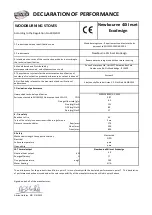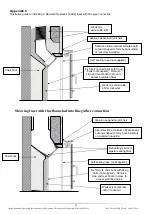
3
Installation and Operating Instructions for Newbourne 40i Inset Inset Ecodesign Multi Fuel Stove
Ref: Pevex1030/AH/ver1: 1 April 2019
It is possible to sweep through the Newbourne 40i Inset stove by removing the lower vermiculite baffle and upper
steel baffle to gain access to the flue pipe. The method of removal is described later in the manual on page 8.
The connecting flue pipe and stove baffle should be checked monthly to clear any fly ash or soot
deposits.
USE OF A FIREGUARD
When using the stove in situations where children, aged and/or infirm persons are present a fireguard must be
used to prevent accidental contact with the stove. The fireguard should be manufactured in accordance with
BS6539.
INSTRUCTIONS FOR USE:
First Firing
The stove has been treated with a heat-resistant coating, which hardens at a temperature of approximately 250
0
C. This hardening process causes the production of smoke and malodorous fumes, so the room must be
very
well ventilated
.
During the first firing,
which should be carried out using approximately 1 kg of wood, the door must be left
slightly open and must not be closed until the stove is cold. This is to prevent the sealing rope sticking to the
stove.
RECOMMENDED FUELS
The recommended fuels that can be burnt on this stove is wood logs and smokeless fuels (see below) of which we
would recommend brown coal or ancit which is approved by Hetas.
Correct firing provides optimal heat output and maximum economy. At the same time, correct firing prevents
environmental damage in the form of smoke and malodorous fumes and also reduces the risk of chimney fires.
Well seasoned woodfuel is essential for correct use. Make sure your fuel is kept dry. If the fuel is wet, a large
proportion of the heat will be used to vaporize the water, and this energy will disappear up the chimney. It is
clearly not only uneconomical to fire with wet fuel but also, as mentioned above, increases the risk of producing
soot, smoke and other environmentally damaging by-products. When wood is used as a fuel, it is important that
it is dry, i.e. wood with moisture content less than 20%. Ideally firewood needs seasoning for at least 2 summers,
logs should be stacked in a well-ventilated situation, and logs over 100mm diameter should be split. The stack
should be protected from rain but remain well ventilated.
Generally dry wood (<20% moisture content) produces 4.5kW/h per kg; semi dry about 3kW/h per kg and wet
wood 1kW/h per kg demonstrating that fewer drier logs are required to produce the same amount of heat output.
APPLIANCE
WOOD LENGTH
Newbourne 40i
Inset
26cm
MIXED FUEL USE
Use of brown coal and smokeless fuel
Uni-logs (brown coal brickettes) may be burned on the stove. Good performance will be obtained using these
brickettes. Anthracite, a naturally occurring smokeless fuel is also recommended to be used. However, avoid
over-firing by overloading the firebox as solid fuel burns hotter and longer than wood therefore reduce the loading
weight to suit the output of the appliance (eg., Anthracite = 8.6kW/kg which means you only need 0.6kg for 5kW
of heat output). Always open the air control every 3 hours for 20 mins to clear any gases that have accumulated
in the firebox.
Some approved smokeless solid fuels may also be used although please be aware that there are multiple blends
available on the market containing different levels of chemicals, petroleum coke and sulphur contents. Some of
the characteristics of these fuels has been known to cause problems with the stove internals and flue system
and therefore we would suggest that a modern fuel such as Ecoal 50 which contains anthracite and biomass be
used. Please read the section below about how to light and use your stove and the problems of slumbering a
stove.
A mixture of seasoned wood and smokeless fuel will provide extended burn times with a good flame picture
Wood length

































